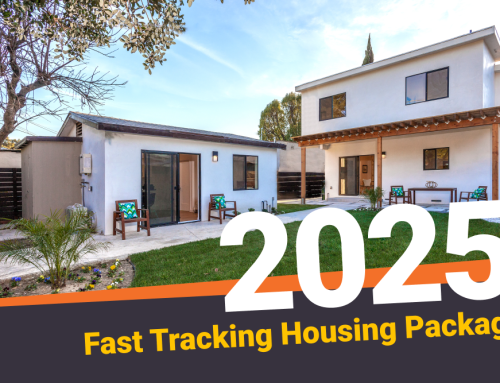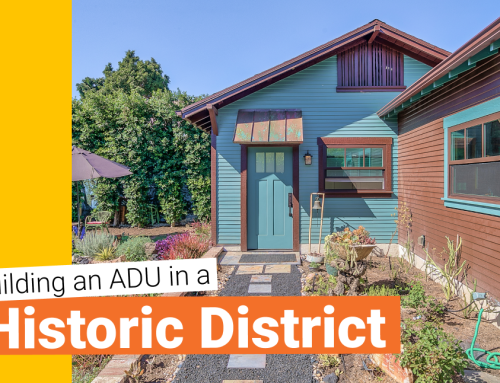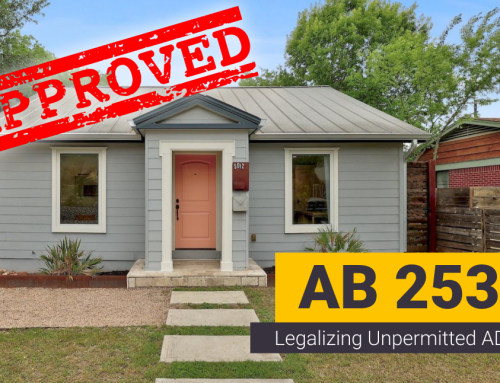Every year seems to bring an avalanche of ADU law changes in California, and 2025 is no different. Don’t fret! These are positive changes. Each bill that we’ve seen make their way through the law making process has made the ADU process easier and easier.
As such, it’s important for you to know your rights to ensure you unlock all the savings and benefits these bills have to offer. Let’s get into it.
1. Every California homeowner is entitled to at least one ADU
If you are a homeowner in California, you are entitled to at least one 800 sq ft, 16 ft tall ADU on your property regardless of lot size, floor-area ratio, or front setbacks.
This is what the state calls a state-mandated ADU or a 66323 unit in reference to the Government code this originates from. (Rolls off the tongue, doesn’t it?)
This means that even if your proposed ADU encroaches beyond the front setback requirements listed in your local building code or your lot is on the smaller side, your planning department must allow you to build at least 800 sq ft.
These ADUs are also exempt from parking requirements.

2. Owner occupancy is not required
Owner occupancy refers to the requirement that the owner of the property must live on the property, either in the main house or the ADU.
AB 976, which was passed in 2024, has eliminated the owner occupancy requirement entirely. Your city cannot require you to live on the property.
3. Garage conversions can be extended by 150 sq ft without penalty
Garage conversions, and all other conversions, come with added benefits like parking and setback exemptions.
A lot of the homeowners are worried to lose these benefits if they decide to expand the garage. Fortunately, with any conversion, you can extend by up to 150 sq ft for ingress and egress. Ingress and egress refers to the areas needed for safe entry and exit, such as doorways, walkways, or small additions that make the space functional. This means you can slightly expand your garage conversion—perhaps for a more spacious entrance or to add a small utility area. 150 sq ft may sound small, but when once you have your ADU built, you’ll be glad you added it.
This isn’t a new addition to ADU laws, but it’s worth mentioning as this is a benefit that is often overlooked.
4. Your city is required to have a pre-approved ADU plans program

If you live in a city with a population of at least 200,000, your local planning department is required to have a pre-approved ADU plans program in place. This is thanks to AB 1332 which was passed in 2023 and has now gone into effect in 2025. The bill does not specify what these programs must have. The programs can be in the form of city-owned ADU plans or architect-owned plans that have been vetted by the city (we prefer the latter).
ADU-friendly cities like San Jose and Los Angeles already have extensive programs and have seen very positive results, but we’re curious to see if less housing-progressive cities will embrace the pre-approved plans mandate with the same enthusiasm.
A quick rundown of pre-approved ADU plans, these plans do not mean you can walk in, purchase a plan you like, and get started on construction. You still will need to submit a full application which will show the city how the ADU will fit onto your property, plus utility connections, Title 24, etc. Still, it’s a quicker and easier process than working on a completely custom design.
Click here for a full run-down on pre-approved ADU plans.
5. There is a new HCD Handbook
The California Department of Housing and Community Development (HCD) has released the newest updated version of their ADU Handbook. This handbook serves as a comprehensive guide for homeowners, builders, and city planners, outlining the most up-to-date laws, regulations, and best practices for building ADUs in California.
Although it’s still quite hefty sitting at 54 pages, it serves as a valuable resource and provides simplified definitions and explanations of Government codes that are usually filled with complicated jargon.

6. There is now more leniency for unpermitted ADUs
Those of you with unpermitted ADUs can breathe a sigh of relief because AB 2533 has further simplified the permitting process.
Previously, unpermitted ADUs were required to adhere to all modern safety and building codes to be legalized. AB 2533 simplifies this process by eliminating the need to comply with non-safety-related building codes, provided the ADU meets minimum safety standards for living spaces. For example, current regulations might require newly installed windows to meet energy efficiency standards, but since this is not a safety issue, it can no longer be enforced as a condition for approval.
But, if you have a leaky roof or a cracked foundation, that will need to be addressed.
7. Up to 8 detached ADUs now allowed for multi-family properties
Thanks to SB 1211, multi-family property owners can now build one detached ADU per living unit on their property, with a max of eight.
This means that if you own a multi-family property with eight or more units, you can add up to eight detached ADUs, significantly increasing the potential housing capacity of your property. These detached ADUs must adhere to the standard size, height, and setback regulations but provide a huge opportunity for landlords to generate additional rental income and address housing shortages in their communities.
These eight detached ADUs are in addition to the conversion ADUs already permitted. SB 1211 also provides further clarification on the definition of livable spaces eligible for conversion within multi-family buildings.

8. Many financing options for ADUs
It’s no secret that ADUs can be a big investment. Luckily, there are multiple financing options for you to choose from based on your financial situation.
Here’s a quick run-down of some of the more common options:
- HELOC: Borrow against your home’s equity as needed, paying interest only on the amount you use. Perfect for flexible, ongoing construction projects.
- Home Equity Loan: Receive a lump sum based on your home’s equity with fixed interest rates and monthly payments. Ideal for homeowners who prefer a predictable repayment plan.
- Cash-Out Refinance: Refinance your mortgage for a higher amount than what you owe and take the difference in cash. A great way to access funds while potentially securing a lower interest rate.
- Construction Loans: Short-term loans designed for financing building projects that can convert to a traditional mortgage once construction is complete.
The California Housing Finance Agency (CalHFA) also frequently releases a $40,000 ADU grant available for low to mid income homeowners. Make sure to subscribe to our newsletter to be the first to know when the grant returns.

9. Your HOA cannot prohibit you from building an ADU
Again, this is an old bill, but because we get this asked so frequently, it’s worth addressing. Your HOA cannot prohibit you from building an ADU on your property. However, your HOA is allowed to set their own regulations as long as they are not too restrictive. There are no guidelines to what is considered “too restrictive” so there can be some ambiguity. Generally, HOAs can set rules regarding the aesthetic aspects of the ADU, such as the design, materials, and placement, as long as those regulations do not make it impractical or impossible to build the unit.
10. Detached ADUs are required to have solar panels
All detached custom-built ADUs are required to have solar panels installed. So to clarify, any ADU that is a conversion or attached will not need to have solar panels. This requirement is part of California’s push for sustainability and energy efficiency in new construction.
Prefab ADUs, which are typically factory-built, are exempt from this regulation.
Get your project started in 2025
Maxable is at the forefront of ADU development, having connected hundreds of homeowners to trusted architects and builders in their area. Our vetting system ensures that you get matched with ADU professionals that have the appropriate knowledge and experience to successfully complete your project.
Need a boost to get started? Download our free ADU tool kit where you’ll find floor plans, regulations cheat sheet, cash flow estimator, and more.








